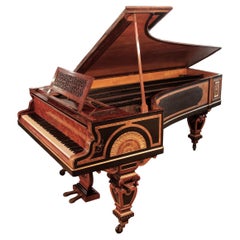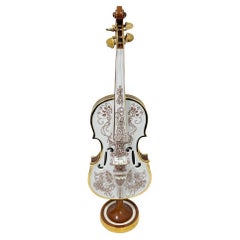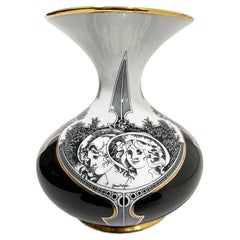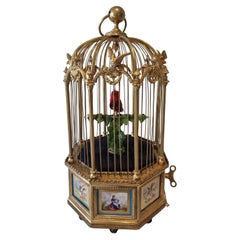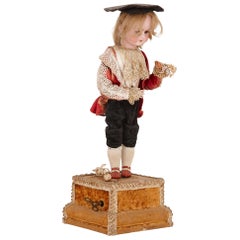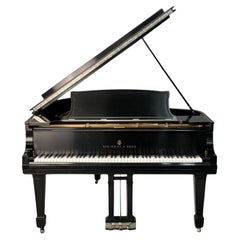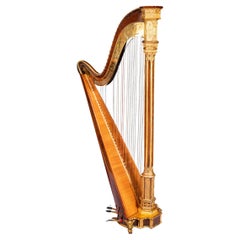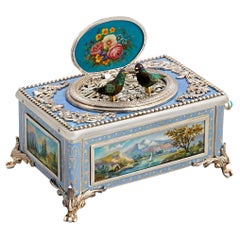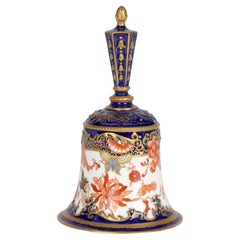Porcelain Musical Instruments
to
1
5
5
1
2
3
1
1
28,357
339
305
107
58
4
2
1
1
5
5
5
2
1
Material: Porcelain
Erard Grand Piano Egyptian Revival Neoclassical Style by William Lomax Walnut
Located in Leeds, GB
An 1861, Erard grand piano with an ornate burr walnut, black and gilt cabinet. Piano casework features Egyptian Revival and Neoclassical elements. Th...
Category
Mid-19th Century English Neoclassical Antique Porcelain Musical Instruments
Materials
Porcelain, Walnut, Giltwood
Endre László Szász for Hollohaza Porcelain Violin
By Endre Szasz
Located in Delft, NL
Endre László Szász for hollohaza porcelain violin, Hungary 1979-1980.
A Hungarian porcelain violin on a round stand with a brown painted scene o...
Category
20th Century Hungarian Porcelain Musical Instruments
Materials
Porcelain
László Jurcsák for Hollohaza Large Porcelain Vase
Located in Delft, NL
László Jurcsák for hollohaza large porcelain vase, Hungary 1982-1992
A Hungarian porcelain vase of 24 cm high. White porcelain with black pain...
Category
20th Century Hungarian Porcelain Musical Instruments
Materials
Porcelain
A stunning Hexagonal shaped, gilt bronze and Sevres Singing Cage by Bontems
Located in London, GB
A stunning and very fine Hexagonal gilt bronze and Sevres plaque single singing bird-in-cage, by Bontems,
Going-barrel movement,
When wound with the key and start/stop lever actuated, the large and perfectly perched red thrush begins to sing his chorus, moving naturalistic beak, tailfeather and head from side-to-side to continuous birdsong.
One of the most sought after and most looked forward to models ever made by Bontems, this example is offered in pristine original condition. Hexagonal shaped, which is one of the rarer models you'll be lucky to come across, with 8 seperate porcelain plaques depicting lovers alternating with song birds within tooled gilt and bleu céleste borders
Gilt bronze singing bird cages, usually with stained glass, or fine porcelain panel inserts, were made in limited numbers during the 19th century to commission orders. The first maker to offer a bird cage to this design was Jacquet Droz in about 1798 with his large singing bird in cage, fusee-driven with a clock to the underside so when hung up, its use was three-dimensional.
Bontems created this with the past in mind and was no doubt the only maker...
Category
1880s Antique Porcelain Musical Instruments
Materials
Bronze
Unusual Continental Bisque Porcelain Automaton Figure
Located in London, GB
Unusual bisque porcelain automaton figure
Continental, circa 1900
Measures: Height 57cm, width 21cm, depth 21cm
This unusual doll takes the form ...
Category
Early 1900s European Antique Porcelain Musical Instruments
Materials
Porcelain, Fabric
$4,170 Sale Price
20% Off
Related Items
Steinway & Sons, Baby Grand Model O Piano, Fully Refurbished, 1911
Located in Manhasset, NY
Steinway & Sons, Baby Grand Model L Piano, Refurbished Satin Ebony, 1911, 88 Keys, Serial Number 146562
This exceptional 1911 Steinway piano, Model 146561, has undergone a complete ...
Category
20th Century American Modern Porcelain Musical Instruments
Materials
Lacquer
Early 19th Century Parcel Gilt Gothic Revival Harp By Sebastian Erard
Located in Dublin, IE
A very fine and elegant Regency Satinwood and parcel-gilt double action Harp from the workshop of the famous harp and piano maker Sebastian Erard (1752-1831), decorated in the Grecia...
Category
Early 19th Century English Gothic Revival Antique Porcelain Musical Instruments
Materials
Brass
$15,118
H 66.93 in W 31.5 in D 20.08 in
Large Vintage Porcelain Cigar Ashtray 1980's
Located in North Hollywood, CA
Large vintage square ceramic porcelain cigar ashtray.
Large collectible cigar ashtray in yellow and black and white check with gilt borders that break at cigar rests at either side.
Gold lettering in the center reads “Cigar”. and there is a knight on horse...
Category
Late 20th Century Post-Modern Porcelain Musical Instruments
Materials
Porcelain
Automaton Singing Birds
Located in Norwich, GB
Automaton Singing birds
Automaton singing birds housed in a gilded case standing on a stepped gilded base.
Three articulated singing bird...
Category
1950s British Vintage Porcelain Musical Instruments
Materials
Brass
Antique KPM Hand-Painted Porcelain Cabinet Plate Depicting the Biblical "Ruth"
Located in Hamilton, Ontario
This antique hand-painted porcelain cabinet plate was made by the renowned KPM porcelain factory of Germany in approximately 1880. The center of the plate features a depiction of the...
Category
Late 19th Century German Neoclassical Revival Antique Porcelain Musical Instruments
Materials
Porcelain
$1,995
H 0.75 in Dm 8 in
19th Century Louis XIV Style Marquetry Baby Grand Piano by Collard & Collard
By Collard & Collard
Located in Los Angeles, CA
A very fine Anglo-French 19th century rosewood, palisander, amboyna and satinwood marquetry (inlaid) art-case baby grand piano, the works by "Collard & Collard". The intricately deco...
Category
Late 19th Century English Neoclassical Revival Antique Porcelain Musical Instruments
Materials
Bronze
$75,600 Sale Price
20% Off
H 40.25 in W 72 in D 55.5 in
Gothic Table Clock w. Stunning Antique Pocket Watch Made of Gilt Bronze or Gold
Located in Lisse, NL
Small Gothic table clock with gilt bronze (or possibly golden) pocket watch by John Worboys of London, 1780-1810.
We know too little about antique ...
Category
Early 1800s British Gothic Revival Antique Porcelain Musical Instruments
Materials
Metal, Bronze
$2,134
H 7.1 in W 5.1 in D 3.55 in
Vintage Karl Griesbaum Automatronic Singing Bird Cage, Made in Germany
Located in Norwood, NJ
Vintage automatronic wind-up singing bird cage crafted by Karl Griesbaum in Germany. Automation makes the caged bird sing, flutter its tail and move its beak and head about. The cage...
Category
Early 20th Century German Victorian Porcelain Musical Instruments
Materials
Brass
Adorable and Therapeutic Musical Clown Automaton Figure Toy
Located in Miami, FL
A fine quality therapeutic musical automaton clown toy in wonderful vintage condition.
Features porcelain head, hands and feet.
Made in France during the ...
Category
Mid-20th Century French Mid-Century Modern Porcelain Musical Instruments
Materials
Metal
$595 Sale Price
40% Off
H 13 in W 5 in D 4 in
Gilt Bronze Brooch by Line Vautrin
By Line Vautrin
Located in Atlanta, GA
A gilt bronze brooch "Moise ou la Traversee du Desert" by French Jeweler Line Vautrin, circa 1940s.
The patinated surface features amazing details illustrating the biblical story of Moses crossing the desert out of Egypt...
Category
1940s French Mid-Century Modern Vintage Porcelain Musical Instruments
Materials
Bronze
Age Art Deco Porcelain Figurine from Hungarian Porcelain Hollóháza
Located in Vigonza, Padua
Age Art Deco porcelain figurine from Hungarian porcelain Hollóháza
About Holloaza
Hollohaza porcelain is one of the oldest porcelain manufactory ...
Category
Mid-20th Century Hungarian Art Deco Porcelain Musical Instruments
Materials
Porcelain
$1,660
H 5.91 in W 4.34 in D 2.76 in
19th Century Meissen Porcelain: Empress Catherine ii of Russia's Favorite Dog
Located in New York, NY
A 19th century Meissen Porcelain Model Of Empress Catherine II Of Russia's Favorite Dog (Russisches Windspiel). This delightful 19th-century Meissen porcelain model depicts Empress C...
Category
1860s German Louis XVI Antique Porcelain Musical Instruments
Materials
Porcelain
$19,080 Sale Price
20% Off
H 6 in W 17 in D 10 in
Previously Available Items
Silver Double Singing Bird Box
Located in New Orleans, LA
One of the rarest examples of a mechanical bird box ever seen, this extraordinary box features not one, but two brilliantly colored love birds. When the lid is opened, the delightful pair begin to sing their sweet, melodious tune, with their bodies, wings and beaks in full motion. While the presence of two singing birds makes this an exceptional rarity, it is distinguished in all other respects as well. The sterling silver casing is handsomely set with panels of powder blue enamel and hand-painted porcelain miniatures decorated with serene seascapes. The complex mechanism has the amazing ability to successfully engage two independently moving birds within a casing typically designed for a single bird. The one-of-a-kind objet d'art was inspired by the mechanical complexity of 19th-century Swiss automata, and it represents the pinnacle of the art form.
Mechanical singing bird boxes...
Category
19th Century American Antique Porcelain Musical Instruments
Materials
Silver, Sterling Silver, Enamel
Royal Crown Derby Rare Antique Imari Pattern Porcelain Bell
Located in Bishop's Stortford, Hertfordshire
A very rare antique porcelain imari pattern bell by Royal Crown Derby and dating from 1904. The bell has a traditional bell shaped body with molded and finely decorated patterning in...
Category
Early 1900s English Art Nouveau Antique Porcelain Musical Instruments
Materials
Porcelain
Blaise Bontems, an Extremely Fine & Rare Automaton Double Singing Bird Music Box
By Bontems
Located in Queens, NY
Blaise Bontems, an extremely fine and rare automaton double singing bird music box, in the form of a Porcelain Jardinière, 1870-1880, Paris.
...
Category
19th Century French Antique Porcelain Musical Instruments
Materials
Porcelain
"Blanc de Chine" Porcelaine Statuettes Traditional Instruments Players
Located in Beuzevillette, FR
Really nice set of seven characters in porcelain "Blanc de Chine", representing women playing traditional chineses instruments: Pipa, Guzheng, Liuqin, Konghou, Dizi, Sheng, Cliquette...
Category
19th Century Chinese Chinoiserie Antique Porcelain Musical Instruments
Materials
Porcelain
Pier Giovanni Urbino, Decorated Ceramic Jewelry Box, Carillon, Italy, 1960s
Located in Roma, IT
Pier Giovanni Urbino Sardella, vintage ceramic decorated jewelry box
Italian, 1960s for Ceramica, black lacquered wood case with inset hand painted porcelain plaques featuring fox h...
Category
1960s Italian Mid-Century Modern Vintage Porcelain Musical Instruments
Materials
Brass
H 2.37 in W 11.42 in D 4.14 in
Recently Viewed
View AllMore Ways To Browse
Music Box Rosewood
Record Player Brionvega
Used Snare Drum
Antique Piano Babies
Space Age Stereo
Vintage 45 Rpm Record
Brass Bugle
Bronze Cow Bell
Castiglioni Record Player
Hans Gugelot
Juke Box
Military Antique Drum
Phonograph Cabinet
Upright Music Box
Used Xylophones
Vintage German Record Player
Vintage Phonograph Players
Cassette Player
